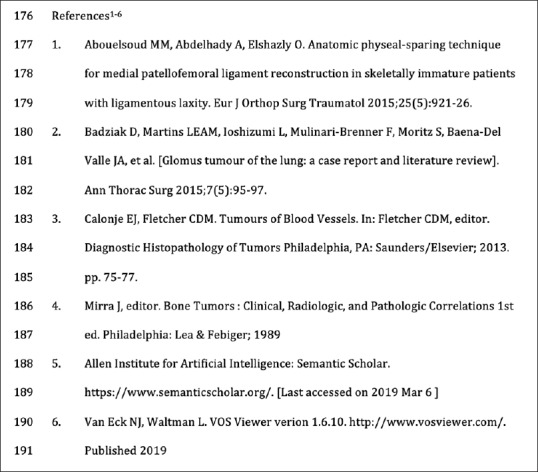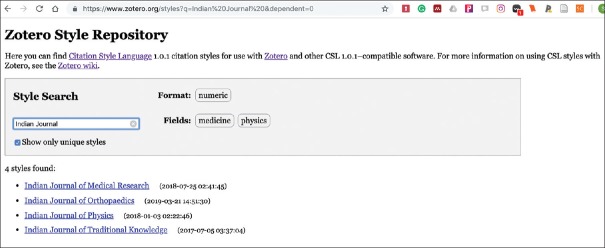While references are an essential and integral part of a scientific manuscript, format and style of references are as varied as the number of journals currently present. International Committee of Medical Journal Editors in their latest recommendations for publication,1 advice authors to quote original references whenever possible. We would recommend the readers to go through these guidelines as they are given in sufficient detail to submit a good set of references including styling. Other resources for citing references include the PubMed section2 which gives samples of formatting of different reference types and the eBook: Citing Medicine,3 published by the U. S. National Library of Medicine, which gives assistance and rules to authors, editors, publishers and librarians for formatting of references for different reference types.
References are formatted in two basic styles – the Vancouver style which is numeric (more commonly used in medical journals) and Harvard which uses author-date style (more commonly used in natural and Social sciences journals).4 Parts and order of the parts cited differ on what the author is citing (reference type) and the journal that is being submitted to. The most common types of references include journal article, book, book section or chapter, dissertation, monograph, and webpage. As an example, for a journal article, the parts of a reference in the sequence include authors, article title, journal title, date of publication, volume, issue, and location/pagination. Each journal has its own modification of the format for each part and the punctuation marks, or their lack of, between the parts. Formatting style in each part of a reference could involve placement of selected punctuation marks, bold and italics enhancements, alphabetical order or sequential ordering of references and style of citing in the text, making the combination of variations that create a unique reference style as large in number as the number of journals currently published. It is not clear why such a system has evolved, but it requires considerable attention to detail to get the formatting correct and is time-consuming for the author. The tradition of the journal has been thought as one of the reasons.4 In manuscripts submitted for the Indian Journal of Orthopaedics (IJO), the reference section carries the most formatting errors committed by authors.
The advantage of having a constant style within a journal is two-fold, apart from an esthetic appearance of references across all articles published by the journal. Ease of reading the references at the end of each article and ease of finding reference part by the reader if he/she is used to the format and plans to look up the reference. As a student/professional in the medical field, one would require attention to finer details of his/her research work as well as in their clinical practice and hence exercising attention to the references would help improve those skills. Such a wide variation in the styles of references has also benefitted some software companies who deal with reference managers (RMs). Some RMs are free for use, and the authors are advised to use different RMs to see which one suits their needs best. While some RMs are cloud based, others are computer based and do not require an internet connection while some others are cloud and computer based. The variation in the style of references across journals appears unlikely to be standardized to a single universal format in the near future.
The Citation Style Language (CSL) is an XML-based computer language developed to standardize formatting of citations and references in manuscripts submitting to journals. They are text application editable files which are imported into RMs. An increasing number of RMs use CSL to help users format their list of references according to individual journal guidelines. However, not all journals are supported by CSL files.
There are two main repositories for access to CSL files – One by GitHub5 and the other by Zotero6 developed by Corporation for Digital Scholarship and Roy Rosenzweig Center for History and New Media. These contain more than 8500 styles of references. Authors using Zotero, Mendeley, RefWorks, Papers, CrossRef, Bibliography, and some 42 other RMs can use these CSL files to manage references within them. IJO did not have a CSL file until now in both the repositories. In this scenario, there are a few options for the authors preparing references for a manuscript. First, to type and style references manually which would take a long time and prone to human errors. Second, a CSL file similar to IJO may be selected from the repository and used and later manually edited, if any needed. However, this involves searching for an exact match of style for a journal registered in the repository of CSL files. Third, there are RMs with inbuilt options to format references while citing in the text. This option is independent of CSL. The disadvantage here is that the author is bound by the list of reference styles already loaded within the software. They may not be able to add new formats. Fourth, some RMs allow authors to prepare a style, but this would take some time to prepare if the style is not already inbuilt. As a fifth option, a CSL file that is close to IJO may be chosen, and the code of this file tweaked with minor editing to convert it for use with IJO. To do that, the author must be familiar with programming or editing of HTML/XML files since HTML is a language that is closer to XML.
Zotero's repository7 website has a user-friendly interface in which such searches are easier to perform. It has 9357 styles stored in the repository at the time of writing this article on March 17, 2019. There are 1924 unique styles through which one can search if their required journal is listed. Zotero draws CSL files from GitHub into their repository. Hence, if a file is created in GitHub, it is drawn into Zotero by default. CSL Project8 is a website sponsored by four well known RMs. These are Zotero, Mendeley,9 Papers,10 and RefWorks.11 This website gives detailed specifications and documentation of CSL language if one is interested in coding these files. If one is proficient with XML, they can create a style and submit it to the GitHub website for others to benefit. Editing is easier if one uses the Zotero RM as it has an inbuilt option to edit style. It can be done even in other managers or with the use of a standard text editing application in Windows or Mac operating systems. Once a new CSL file is developed, in order to publish it, it has to be validated by CSL validator website12 and submitted at the GitHub site for accepting into the repository. Even finer details like number of author names before et al. while formatting reference, punctuation marks and their placement, style of each part of the reference and each style of the reference, etc., can be edited accurately.
Once developed, the output of references and citations is remarkably consistent, and too much time need not be directed to editing the punctuation marks and styling of the references and citations while preparing the manuscript. The only hurdle after this would be to get full details of the references reliably and accurately into the RM database while importing the references. The author needs to check that the references were properly imported into the database. If verified, they may be used any number of times with precision. With appropriate selection, the citing as well as the list of references can be formatted according to the journal that is being considered, for submission. Those who are already using RMs may be well aware of the advantages and the time such CSL files can save while preparing a manuscript.
We are happy to inform that a CSL file for IJO has now been created in the GitHub repository1 and Zotero Styles repository3 and it can be used by authors using the RMs listed in the CSL website and benefit from its use. The direct link of the file in the repository is given13 [Figure 1]. Basic users of RMs may download it through their RMs by selecting Indian Journal of Orthopaedics option. Advanced users who know where to place this file may access using the weblink given. Examples of reference style and citation for IJO are given in Figure 2.
Figure 1.
Screenshot of browser shows the web address and search words used to retrieve Citation Style Language file for Indian Journal of Orthopaedics
Figure 2.

Examples of format of references and their citation in text for the Indian Journal of Orthopaedics
References
- 1.International Committee of Medical Journal Editors. Recommendations for the Conduct, Reporting, Editing, and Publication of Scholarly Work in Medical Journals. 2018. [Last accessed on 2019 Mar 23]. Available from: http://www.icmje.org/icmje-recommendations.pdf . [PubMed]
- 2.U.S. National Library of Medicine. Samples of Formatted References for Authors of Journal Articles. [Last accessed on 2019 Mar 23]. Available from: https://www.nlm.nih.gov/bsd/uniform_requirements.html .
- 3.Patrias K, Wendling D. Citing Medicine. The NLM Style Guide for Authors, Editors, and Publishers. 2nd ed. 2007. [Last accessed on 2019 Mar 23]. Available from: https://www.ncbi.nlm.nih.gov/books/NBK7256/
- 4.Harries AD, Kumar AM, Satyanarayana S, Bissell K, Hinderaker SG, Edginton M, et al. References for scientific papers: Why not standardise to one global style? Public Health Action. 2013;3:255–7. doi: 10.5588/pha.13.0066. [DOI] [PMC free article] [PubMed] [Google Scholar]
- 5.GitHub. [Last accessed on 2019 Mar 17]. Available from: https://www.github.com/citation-stylelanguage/styles .
- 6.Zotero. [Last accessed on 2019 Mar 17]. Available from: https://www.zotero.org/
- 7.Zotero Styles Repository. [Last accessed on 2019 Mar 17]. Available from: https://www.zotero.org/styles .
- 8.Citation Style Language. [Last accessed on 2019 Mar 17]. Available from: https://www.citationstyles.org/
- 9.Mendeley. [Last accessed on 2019 Mar 17]. Available from: https://www.mendeley.com/
- 10.Papers. [Last accessed on 2019 Mar 17]. Available from: https://www.papersapp.com/
- 11.RefWorks. [Last accessed on 2019 Mar 17]. Available from: https://www.refworks.proquest.com/
- 12.Citation Style Validator. [Last accessed on 2019 Mar 17]. Available from: https://www.validator.citationstyles.org/
- 13.Kambhampati SB. CSL File. Indian J Orthop. [Last accessed on 2019 Mar 21]. Available from: https://www.zotero.org/styles/indian-journal-of-orthopaedics .



